
After playing in event after event, it becomes clearer and clearer each time that no matter how much you test and prepare, sometimes it's just not your day. Regardless of how good you are, how sick your deck is, or how much technology you've packed into your seventy-five, sometimes you just don't quite get there. Long story short, I did pretty poorly at Regionals. This was partly due to my card choices, partly due to bad luck, and partly due to my own misplays. I did, however, learn a lot about how the format has grown and what to expect for the PTQ season, so I'm not really that disappointed with the whole endeavor. After all, we learn more from losing than we do from winning.
So, where did I go wrong? Well, there's a bit of a story leading up to that. On Thursday night, I headed to Travis Ladouceur's place in Troy, MI to do some testing for the event. We were both pretty certain we wanted to play Five Color Blood, and so we started coming up with the final list we'd be battling with on Saturday. Considering that we didn't have a whole lot of time, we tested with the Putrid Leechless version of the deck, the one that we both had the most experience playing. We eventually settled on this list:
| Five Color Blood As suggested by Chris Jobin and Travis LadouceurMagic OnlineOCTGN2ApprenticeBuy These Cards |
||
|---|---|---|
|
Lands 4 Vivid Creek 2 Vivid Grove 2 Vivid Meadow 2 Vivid Marsh 1 Vivid Crag 4 Reflecting Pool 2 Twilight Mire 2 Fire-lit Thicket 2 Mystic Gate 2 Sunken Ruins 2 Island | Creatures 4 Kitchen Finks 3 Anathemancer 4 Bloodbraid Elf 4 Mulldrifter 2 Shriekmaw Other Spells 4 Cryptic Command 3 Maelstrom Pulse 3 Jund Charm 2 Pyroclasm 2 Makeshift Mannequin 2 Runed Halo 2 Esper Charm | Sideboard 2 Identity Crisis 3 Thought Hemorrhage 1 Volcanic Fallout 1 Infest 2 Cloudthresher 2 Wrath of God 1 Runed Halo 1 Anathemancer 2 Puppeteer Clique |
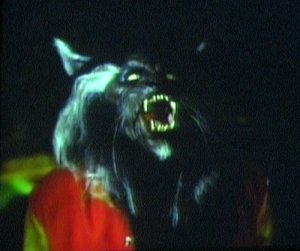
No, not that kind of werewolf.
Once Jason and I finally got back to the house, we stayed up for another hour brewing him up a GW Tokens list (complete with a single Condemn in the sideboard, which was only included because I happened to have one in my extras box). Feeling satisfied with his deck, he headed off to bed. I, on the other hand, wasn't quite sure about mine. Travis had long since went to bed, and so I couldn't talk to him about the potential changes to our list. Instead, I sleeved up Faeries and built a sideboard for it, making sure it was ready to go in case Ari agreed to play it with me.
In the morning, I walked immediately up to Ari and inquired about his deck choice. He shrugged and told me he still wasn't sure, and I merely picked up a second registration sheet and prepared for the worst. I gathered some opinions on what deck to play from my most trusted associates, but in the end I knew it would boil down to whichever deck I personally felt was the strongest. The field that I had scouted looked pretty saturated with Blood decks, but even more so with token decks (no surprise there). I later saw Ari and DJ with Faerie decks sprawled out in front of them, though it was pretty clear only DJ was actually going to be playing the deck. Discouraged, I sat down for the Player's Meeting without making a final decision. In one hand, I had 5CB. In the other, the sickest Faeries list I've built in a while. The judge asked for my decklist, and I handed him the one in my left hand, stashing the other in my bag.
I decided to play with Bloodbraid Elf.
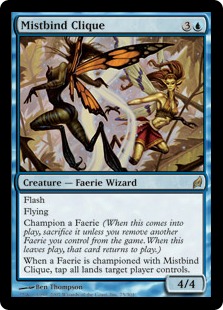
The end of the road?
***
It's not all bad, however. 5CB was an insane deck, even though the version I played wasn't the optimal version. In the first round, I played against my good friend Greg Park playing BW Tokens. Greg was arguably the only good player I played last weekend, and he was also my only win (the very definition of irony). In the first game, he played a turn two Tidehollow Scullers, taking a Jund Charm from my hand. On the following turn, he took a Maelstrom Pulse with a second, leaving me with no way to deal with his 2/2s. I Esper Charmed afterward, untapped, and played a freshly-drawn Maelstrom Pulse for the blowout. I won that game pretty handily from there on.
In the second game, I mulled to five and curved out like a champ. I eventually stalled out, and so did he. He drew into a Mutavault, though, and I had nothing but lands. In the third game, I had some nice draws and made pretty quick work of things (that is, I drew six sweepers). In all three games, he never once was able to activate Windbrisk Heights, despite having at least one each game. That's right - even on the mull to five, I still was able to completely nullify his ability to play cards from under Windbrisk Heights. Like I said, the deck is bonkers.
My second round was awkward. My opponent was playing Jund Ramp, and dropped a Chameleon Colossus on the third turn. I was absolutely cold to it, too, and quickly took a heavy beating. I had to mulligan to five the second game, keeping the Reflecting Pool/Island hand. Any filter or Vivid land off the top made my hand pretty nutty, and so I naturally drew the one and only remaining Island from the deck and promptly conceded. Like I said, awkward. I didn't even think Jund Ramp was a very good deck.
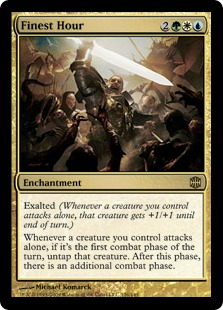
Awkward...
So, well, yeah...it was a bad day for me (now that I think about it, it was a bad day for a lot of my teammates as well). I think I would have done a lot better had I been playing with Putrid Leech, but I don't know for sure how much that would have mattered against the Jund deck anyway. A huge congrats goes out to my good friend and teammate Ari Lax, though, for winning the whole thing. Congrats also go out to Brandon Messner and Josh Wludyka for their Top 8s, and to Jason Newill for his near-miss. Ninth place is rough, dude, and I feel for you. And, just because I said I would... you're pretty much the stoneblade, man. Our GW list was sick, but it just didn't get there. I also want to apologize to Greg Park for dreamcrushing him in the first round and then proceeding to lose my next two rounds. I owe you one, bro.
***
So, now that everything is said and done, what have I learned? Here's all my thoughts, in a quick and handy list:
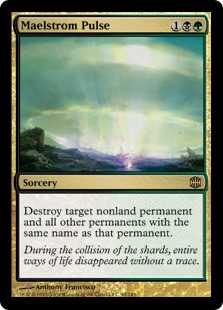
Absolutely nuts.
- Faeries is probably dead
- ] Bloodbraid Elf is arguably the most powerful card in the format
- ] Maelstrom Pulse is over-the-top amazing
- Putrid Leech is basically Tarmogoyf
- ] The format is less defined by Zealous Persecution, and more so by Anathemancer
- ] Kitchen Finks is the most popular card in Standard
- ] Jund Charm might just be the best sweeper in the format
I already went over the Faeries issue earlier, but now it's time to talk a bit more about the rest of the list. You'll notice just by glancing over it that every card I mention in it is found in the deck I played this weekend. I'd imagine that any onlooker would think that this is simply a bias, but I assure you that it is not. Maelstrom Pulse is simply savage in an environment filled with token decks, and any player who played a deck of that nature at Regionals will undoubtedly attest to that. Kitchen Finks is in almost every single deck in the format, and so in this case everyone can unanimously agree that that card is just as good as it gets. I mean, how could you possibly ask for more out of your creatures?
Anathemancer is a problem that every deck in the format must face or die. The strength of your deck is directly correlated to how well you either utilize your own Anathemancer or defend yourself against it. This is where Jund Charm comes in, as it not only serves as yet another sweeper against the token decks, but also as a way to deal with opposing Anathemancers. There's nothing more annoying than paying seven mana only to have your opponent remove your graveyard in response to the unearth trigger. This play was ridiculously common in playtesting, and I have a feeling that it will become ever more relevant as the format evolves.
Lastly, there is Putrid Leech. Folks, he's a 4/4 for two mana. The only creature to come close to those stats would be Tarmogoyf himself, and that's exactly why he got the nickname "Goyf" in testing. In fact, I'm pretty sure Dan Overbeek announced him as Tarmogoyf each time he played him at Regionals. Now, I'm not in any way suggesting that he is indeed a new Tarmogoyf, but rather that everyone who doubts in this card needs to pick it up and play with it truly understand how well he plays and how perfectly he fits into both aggressive decks and control decks. 4/4s for two mana are just too good not to play, after all. My biggest regret from Regionals is easily that I did not choose to play this card, though that decision was based almost entirely on the fact that I hate playing decks blind like that. In retrospect, though, I've pulled stunts like that before and actually done very well despite not knowing my deck as well as I usually do. Oh well, right?
So where exactly am I going with this? Right now in Standard you have a good deal of options when choosing a deck, but it can often be hard to decide on one solid archetype these days. Most people default to BW or GW Tokens, because these decks have far and away the greatest number of Top 8s and wins. However, I don't think this is the best way to tackle the format. Rather than attempt to win out by "teching" against the mirror all day, why not play a deck that can really bring a strong game against the token decks and also just wreck most everything else? To those undecided on what deck to play for the PTQ season, I say look no further than the Blood deck. You can play every card that I talked about above, as well as Cryptic Command and Cruel Ultimatum. You can ravage your opponents with Anathemancer, and protect yourself against it with a sweep/pump/graveyard-nuking spell all in one. The Blood deck packs the format's very best cards into one deck, but in a meaningful way. Every single cascade will hit something relevant, and all of your possible "double spells" give you nothing but value.
The biggest problem most people have with the Blood deck is that it has a very shady manabase, especially the one that Ari played. For reference, here is his list:
| Five Color Blood As suggested by Ari LaxMagic OnlineOCTGN2ApprenticeBuy These Cards |
||
|---|---|---|
|
Lands 4 Vivid Grove 4 Vivid Marsh 3 Vivid Crag 2 Vivid Creek 4 Reflecting Pool 2 Cascade Bluffs 2 Twilight Mire 1 Sunken Ruins 1 Flooded Grove 1 Forest 1 Mountain 1 Swamp | Creatures 4 Putrid Leech 4 Kitchen Finks 4 Anathemancer 4 Bloodbraid Elf 1 Cloudthresher Other Spells 4 Cryptic Command 4 Maelstrom Pulse 3 Pyroclasm 2 Jund Charm 3 Bituminous Blast 1 Cruel Ultimatum | Sideboard 1 Cruel Ultimatum 1 Identity Crisis 1 Cloudthresher 2 Broodmate Dragon 2 Pithing Needle 2 Burrenton Forge-tender 3 Jace Beleren 3 Wrath of God |
Ari will talk about his own deck and outline his own changes and such in his Regionals article here on MTGS, so I won't get into that. Instead, let's address the issues that people have with this deck.
Initially, most people point out that cascade itself is a pretty random mechanic, and building a deck to utilize it is pretty loose. However, this is a pretty awful argument if you've at least looked over a 5CB list. At any given point, if you play a Bloodbraid Elf, you're doing any of the following: wiping the board, destroying a problem permanent (or multiple), hitting your opponent for four or more damage and getting a blocker, gaining two life and getting a 3/2 blocker (that can block twice), getting a 4/4 blocker, pumping a creature, or removing a graveyard from the game. That's obviously a lot of effects that could happen, but they are generally narrow and are all tuned to combat the current metagame. Against token decks, you have a very high chance of clearing the board or blowing up several tokens whenever you cascade, and you have a relatively high chance of producing a blocker, source of lifegain, or the last few points of damage in the other match-ups. Besides, I would never be upset about gaining 2 life and getting two 3/2 blockers for four mana against any creature-based deck, and nor would I be upset with that against a control deck. The idea is that by limiting the types of effects that can occur when you cascade like this deck does, you can create a controlled cascade engine that almost legitimately tutors for whatever it is that you need at the time. An insanely large amount of the time, if your cascade isn't for the exact card (or at least effect) that you wanted, the card advantage that cascade generates on its own will usually be more than enough to keep you alive until you can get to the card you initially wanted anyway.

The future of Standard.
I assure you, with not a single strand of doubt in my body, that cascade is not a gimmick. It is not some cute trick that is getting a lot of hype right now. No, it may just completely change the face of Standard. Each of the cascade spells shows some promise, though Bloodbraid Elf is far and away the most powerful of the bunch. Bituminous Blast's power level is through the roof as well, and I'm quite sure it will become the premier removal spell in the format before long. Kathari Remnant, Captured Sunlight, and Enlisted Wurm stand out to me as well, though finding them a place in Standard might be tougher than it initially appears.
To make a long story short, though, the general point here is that I think you should play Bloodbraid Elf. How you choose to do this is ultimately up to you, but I think playing it alongside Cryptic Command, Maelstrom Pulse, Putrid Leech, and Anathemancer is the way to do it. If you're still questioning the inclusion of Cryptic Command (and blue in general) in the deck, you can give this list a try:
| Jund Blood As suggested by Chris JobinMagic OnlineOCTGN2ApprenticeBuy These Cards |
||
|---|---|---|
|
Lands 4 Reflecting Pool 4 Savage Lands 4 Treetop Village 4 Twilight Mire 3 Fire-lit Thicket 2 Forest 2 Mountain 2 Swamp | Creatures 4 Putrid Leech 4 Kitchen Finks 4 Anathemancer 4 Bloodbraid Elf 3 Chameleon Colossus 2 Cloudthresher | Other Spells 4 Bituminous Blast 4 Maelstrom Pulse 3 Jund Charm 3 Pyroclasm |
This takes the deck in a much more aggressive direction, though you could take it an additional step further and cut the sweepers in favor of Boggart Ram-Gang and Incinerate or something, although that's probably too close to pure aggro than I'm willing to take the deck. Cutting the two other colors allows us to play Treetop Village, which I think could be pretty huge in the long run. Chameleon Colossus is also pretty sick as it gives us a defense against, well, Chameleon Colossus. I think that card is back in a big way right now, and playing our own might not be a terrible idea.
Still, I don't think this is the right way to play the deck. Blue and white give the deck a ton of tools to fight the metagame, and Cryptic Command is just too sick. It you're not stopping game-defining threats, you're tapping down their team for the win. I was initially in the group that was considering cutting that card, but at this point I just can't get behind the idea. It's simply too important.
***
So, despite Regionals being a total flop for me in particular (it's tough here in Michigan, after all), I'm feeling pretty optimistic for the PTQ season. A stale and bland format has now been blown wide open, and I can't wait to jump in head-first. Cascade is the name of the game, and I fully intend to be playing Bloodbraid Elf and Bituminous Blast in some shape or form for the rest of the summer, as I feel strategies playing these cards are the real deal. If you can build around these cards and keep your cascades controlled and relevant, you'll undoubtedly have great success.
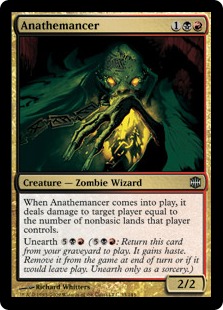
Could be good with Lark, right?
The token decks (and I'm counting BW Kithkin in this category) are of course solid choices, but I'm not sure how confident I'd feel in taking one of those decks to a PTQ. I mean, unless you have some honest-to-goodness amazing technology for the mirror, you're pretty much gambling with nothing but your playskill. I'll be the first to say that being the better player can take you a great distance, but sometimes your draws just don't hold up, and you'll lose even when you "should" be winning. I'd rather play a deck that preys on the metagame rather than go along with it, which is why I not only champion the cascade/Blood decks, but also even a narrower strategy like the Lark deck I just spoke of. One of my biggest recommendations concerning this format is to include Thought Hemorrhage in your sideboard if you can produce the mana. It's arguably one of the most useful sideboard cards in Standard right now, and is absolutely essential to any deck wanting to protect itself from Anathemancer. Whether you're playing Blightning, Jund Ramp, Five Color Blood, or even Five Color Control (not that I'm very confident that this deck will exist much longer), I wouldn't leave home without at least two to three of these in your sideboard.
In any case, Standard is changing. Alara Reborn has completely shaken things up, something a third set hasn't done in a long, long time. At this point, I'm not entirely sure what I'll be writing about next week, but I'll try my best to make it was relevant as I can to those making the trip to Grand Prix: Seattle/Tacoma.
Until next time,
Chris "Shinjutsei" Jobin
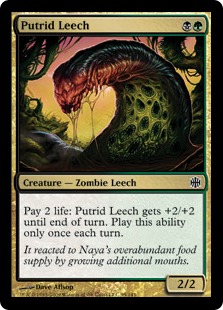
Comments